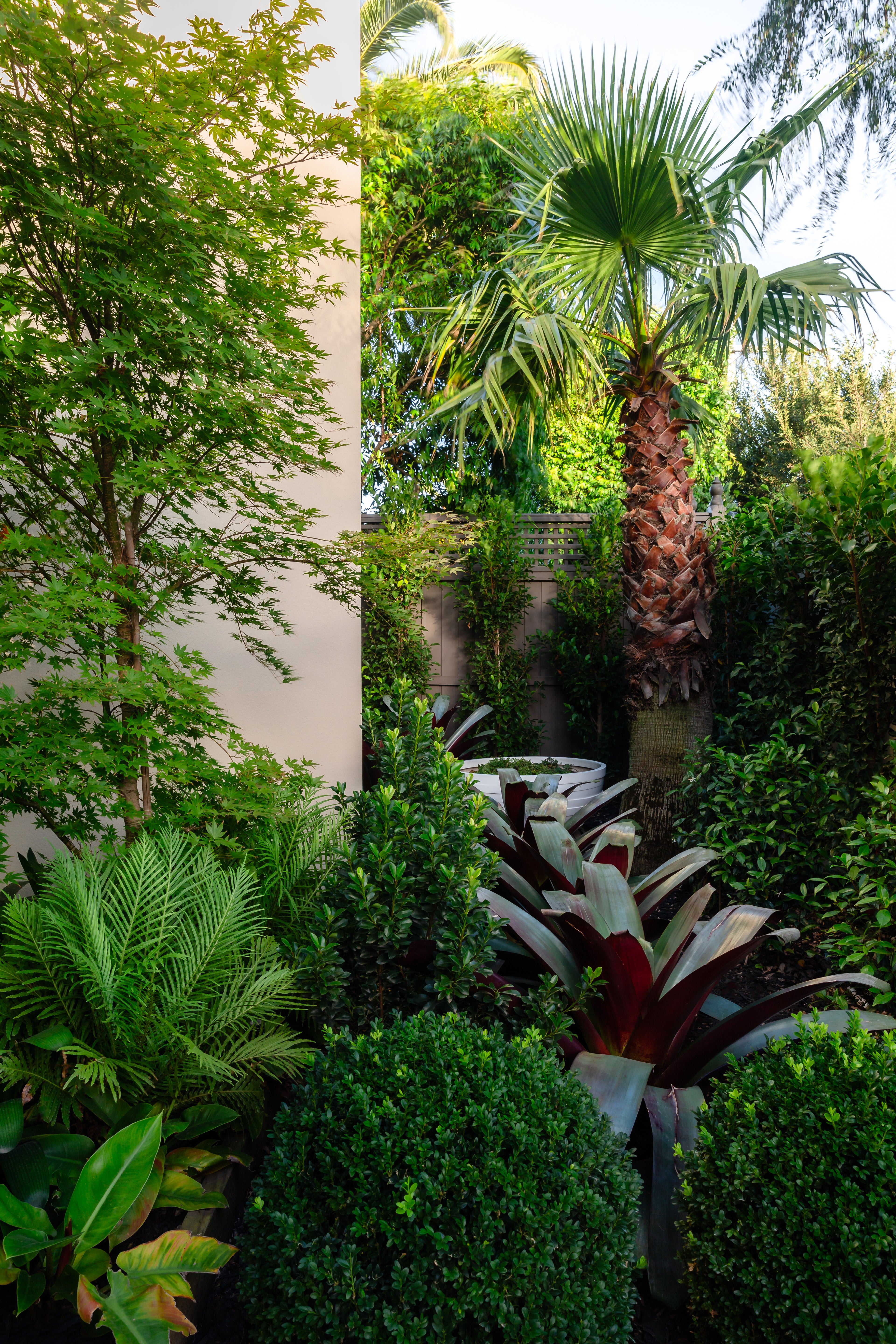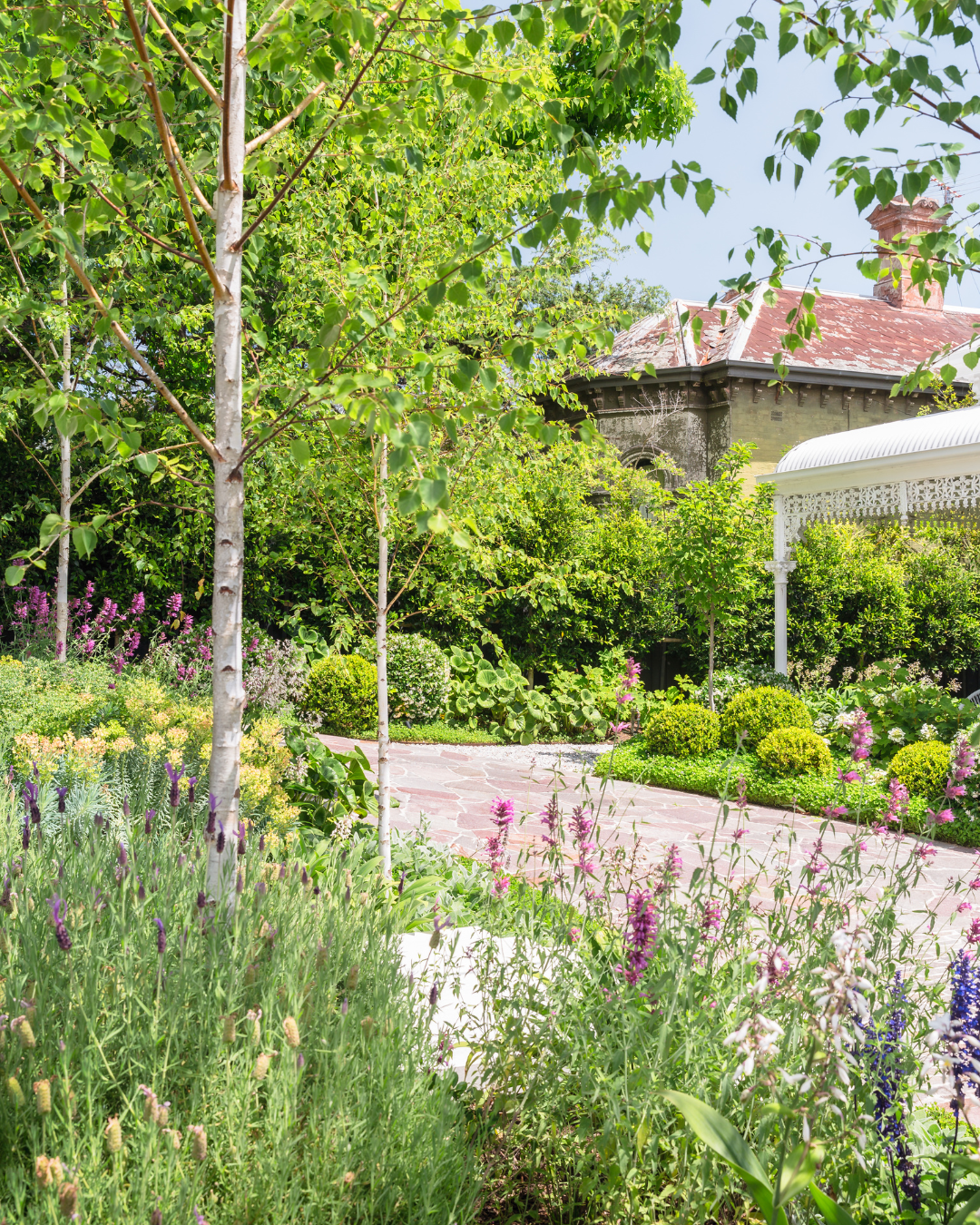Seeking the perfect shade tree for your garden? Look no further. From the bloom-rich Lagerstroemia indica Natchez to the fiery foliage of Acer Negundo Sensation, there's a tree to suit every aesthetic. Whether you're drawn to the broad leaves of Magnolia Teddy Bear or the iconic purple carpet of Jacaranda, these trees promise more than just shade. They bring unique beauty, ensuring your garden is both cool and captivating. Dive in as we explore these garden gems.
1. Lagerstroemia indica Natchez – Crape Myrtle
The Lagerstroemia indica Natchez, commonly known as Crape Myrtle, is renowned for its showy white blossoms that grace gardens during the summer. As a shade tree, it not only offers respite from the sun but also enhances the landscape with its attractive bark and vibrant autumn foliage.
Key Facts to know:
- Mature Height: Typically 6-8 meters.
- Mature Width: 4-5 meters.
- Best Uses: Shade provision, ornamental planting, street tree.
- Leaf Appearance: Green leaves that transition to stunning shades of orange and red in the fall.
- Rate of Growth: Moderate.
- Tolerates: Full sun, prefers well-drained soils.
- Additional Features: Distinctive exfoliating bark, drought-tolerant once established, and resistant to mildew.
2. Acer Negundo Sensation – Box Elder Maple
The Acer Negundo Sensation, part of the Box Elder Maple family, is celebrated for its brilliant fall coloration, making it a visual delight in gardens. As a shade tree, its expansive canopy provides a cooling refuge during the warmer months while adding a touch of ornamental beauty with its vibrant leaves.
Key Facts to know:
- Mature Height: Typically 9-12 meters.
- Mature Width: 6-8 meters.
- Best Uses: Shade provision, ornamental planting, focal point in gardens.
- Leaf Appearance: Pinnately compound leaves that display a striking red hue in the fall.
- Rate of Growth: Fast.
- Tolerates: Full sun to partial shade, adaptable to a range of soil types.
- Additional Features: Low maintenance, known for its impressive fall color transformation, and suitable for urban settings due to its pollution tolerance.
3. Acer Palmatum – Japanese Maple
The Acer Palmatum, commonly known as the Japanese Maple, is renowned for its beautifully shaped, often intricately dissected leaves. Its varying color palette across seasons, from vibrant greens to rich reds, makes it a quintessential ornamental tree for gardens. As a shade tree, it offers a dappled, gentle shade, making it ideal for underplantings or as a standalone focal point.
Key Facts to know:
- Mature Height: Typically 5-8 meters, though some cultivars remain smaller.
- Mature Width: 4-6 meters.
- Best Uses: Ornamental centerpiece, underplantings, zen or themed gardens.
- Leaf Appearance: Varies between cultivars but often palmate, with colors ranging from green to red and even purple.
- Rate of Growth: Slow to moderate.
- Tolerates: Prefers partial shade but can handle full sun in cooler climates; best in well-drained, slightly acidic soil.
- Additional Features: Its leaves undergo a captivating color transformation in the fall. With numerous varieties available, gardeners can choose the perfect fit for their landscape vision.
4. Angophora Costata – Sydney Red Gum
The Angophora Costata, also known as the Sydney Red Gum or Smooth-barked Apple, is a native Australian tree admired for its distinctive, twisting branches and deep red bark that sheds in flakes. This tree casts a broad shade, making it a welcome refuge during hot summer months and a great addition to gardens where shade and unique aesthetics are sought.
Key Facts to know:
- Mature Height: Typically 15-25 meters.
- Mature Width: 10-15 meters.
- Best Uses: Providing shade in parks or large gardens, focal points in native gardens.
- Leaf Appearance: Broad, lanceolate leaves that are a rich green.
- Rate of Growth: Moderate.
- Tolerates: Well-drained to sandy soils; it's adaptable to a range of soil pH levels. It can handle occasional flooding.
- Additional Features: Its striking appearance includes contorted limbs and branches. The tree also produces white to cream-colored flowers in clusters during the summer, attracting various native wildlife.
5. Magnolia 'Teddy Bear' – Southern Magnolia
The Magnolia 'Teddy Bear' is a compact and evergreen variety of the classic Southern Magnolia. Renowned for its luxurious, large, glossy leaves and equally impressive fragrant, creamy-white blossoms, this tree provides both shade and ornamental value. Its dense, upright growth makes it perfect for smaller gardens that need shade without overwhelming the space.
Key Facts to know:
- Mature Height: Typically 4-6 meters.
- Mature Width: 3-4 meters.
- Best Uses: Feature tree, smaller gardens, container planting, or as a backdrop in mixed borders.
- Leaf Appearance: Large, glossy dark green on the top and bronze-brown velvety underneath.
- Rate of Growth: Moderate.
- Tolerates: A range of soils but prefers well-drained soil. It can handle partial shade but thrives in full sun.
- Additional Features: The fragrant flowers, which can span up to 20 cm, bloom in late spring to summer, making it a delightful sensory addition to any garden. Its compact nature also means minimal pruning.
6. Cercis 'Forest Pansy' – Eastern Redbud
Cercis 'Forest Pansy' is a mesmerizing small tree, famed for its striking purple leaves and delicate rose-pink flowers. As an ornamental specimen, it's hard to beat, especially when seeking a tree that delivers both shade and a burst of color. Its heart-shaped foliage and springtime blooms make it a beloved choice for gardeners wanting a touch of drama and romance in their landscapes.
Key Facts to know:
- Mature Height: Typically 4-6 meters.
- Mature Width: 4-5 meters.
- Best Uses: Feature or specimen tree, underplanting with shade-loving plants, focal point in gardens.
- Leaf Appearance: Heart-shaped leaves that start as a vibrant red-purple and mature to a deep purplish-green.
- Rate of Growth: Moderate.
- Tolerates: Various soil types but prefers well-drained soils. It can flourish in full sun to partial shade.
- Additional Features: Its breathtaking rose-pink flowers bloom in early spring, even before the foliage emerges, offering a spectacular floral show. As autumn approaches, the leaves turn a fiery shade of red, adding yet another season of interest.
7. Robinia 'Frisia' – Golden Robinia
Robinia 'Frisia' is renowned for its golden-yellow foliage, setting gardens alight with its luminescent hues. This deciduous tree's brilliance doesn't wane with the seasons, making it an excellent choice for gardeners seeking a consistent and vibrant shade tree that can stand out and capture attention.
Key Facts to know:
- Mature Height: Typically 10-12 meters.
- Mature Width: 4-6 meters.
- Best Uses: Specimen tree, focal points in gardens, boulevards, or parks.
- Leaf Appearance: Pinnate leaves that are a brilliant golden-yellow, especially when young.
- Rate of Growth: Fast when young, slowing down as it matures.
- Tolerates: A variety of soil types but prefers well-drained soils. It thrives in full sun, which also enhances its golden hue.
- Additional Features: Beyond its stunning foliage, the Golden Robinia produces fragrant, pea-like white flowers during spring. In the autumn, its leaves turn to a softer yellow, with hints of orange, making it a spectacle throughout multiple seasons. However, gardeners should note its potential to sucker and may need to manage its growth accordingly.
8. Zelkova serrata – Japanese Zelkova
The Japanese Zelkova is celebrated for its graceful, vase-like shape and elegant branching. Often used as a substitute for the American Elm due to its resistance to Dutch Elm Disease, it showcases a fantastic array of seasonal colors, making it a favorite choice for those desiring a shade tree that also brings aesthetic beauty to gardens.
Key Facts to know:
- Mature Height: Typically 20-25 meters.
- Mature Width: 15-20 meters.
- Best Uses: Street tree, large gardens, parks, and landscapes where shade and aesthetics are desired.
- Leaf Appearance: Simple, ovate leaves with serrated margins that turn from a deep green in summer to captivating shades of yellow, orange, and even reddish-purple in the fall.
- Rate of Growth: Moderate.
- Tolerates: A wide range of soil conditions, but prefers well-drained soils. It is adaptable to both full sun and partial shade environments.
- Additional Features: The Japanese Zelkova's bark exfoliates as the tree matures, revealing an attractive patchwork of gray, orange, and brown. This tree is not only drought-tolerant once established but also offers good wind resistance, making it a resilient choice for various landscapes.
9. Tilia cordata – Small-Leaved Lime or Littleleaf Linden
The Small-Leaved Lime, commonly known as Littleleaf Linden, is cherished for its heart-shaped leaves and aromatic flowers. With a dense canopy, it's an excellent shade tree that also attracts pollinators during its bloom, enhancing garden biodiversity.
Key Facts to know:
- Mature Height: Typically 20-25 meters.
- Mature Width: 10-15 meters.
- Best Uses: Parks, large gardens, avenues, and any landscape where shade and a pleasant aroma are desired.
- Leaf Appearance: Heart-shaped leaves with a lustrous dark green color, turning yellow in the fall.
- Rate of Growth: Moderate.
- Tolerates: Adaptable to various soil conditions, prefers well-drained soils. Best in full sun to partial shade.
- Additional Features: In early summer, the tree produces fragrant, pale yellow flowers that are a favorite of bees. Moreover, the Littleleaf Linden is relatively resistant to most pests and diseases, making it a durable choice for urban and suburban settings.
10. Jacaranda – Jacaranda mimosifolia
The Jacaranda tree is renowned for its striking display of vibrant purple-blue flowers that bloom in late spring and early summer. Apart from being a visual delight, it provides a dappled shade, making it ideal for garden relaxation spots or streetscapes.
Key Facts to know:
- Mature Height: Typically 10-15 meters.
- Mature Width: 8-12 meters.
- Best Uses: Gardens, parks, and streets, especially in areas where a colorful floral display is desired.
- Leaf Appearance: Fern-like, bipinnate, green leaves that give a feathery appearance.
- Rate of Growth: Moderate to fast.
- Tolerates: Prefers well-drained soils and full sun. It's somewhat drought-tolerant once established but appreciates regular watering during dry spells.
- Additional Features: Beyond its renowned blooms, the Jacaranda has a smooth, gray-brown bark and can sometimes produce woody seed capsules. Its distinct flowering period often serves as a herald of the upcoming summer in many regions.
11. Betula Pendula 'Moss White' – Silver Birch 'Moss White'
The Silver Birch 'Moss White' is a distinctive tree characterized by its white, papery bark that adds a touch of elegance to any garden. Its light canopy offers filtered shade, making it perfect for underplanting or simply enjoying a serene, shaded spot beneath its branches.
Key Facts to know:
- Mature Height: Typically 10-20 meters.
- Mature Width: 5-10 meters.
- Best Uses: Ornamental gardens, parks, and naturalized settings.
- Leaf Appearance: Delicate, serrated, triangular green leaves that turn yellow in autumn.
- Rate of Growth: Moderate.
- Tolerates: Prefers well-drained soils, but can adapt to various soil types. Full sun to partial shade is ideal.
- Additional Features: The 'Moss White' variety of Betula Pendula is particularly notable for its striking white bark. The tree also provides habitat and food for a range of wildlife, making not only a beautiful choice but an ecological one as well





















